preparationoutline(文稿提纲)
- 格式:doc
- 大小:71.50 KB
- 文档页数:7
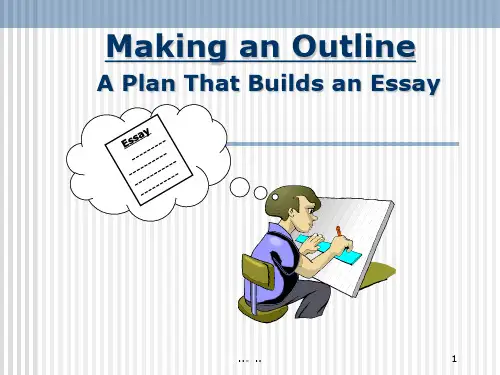
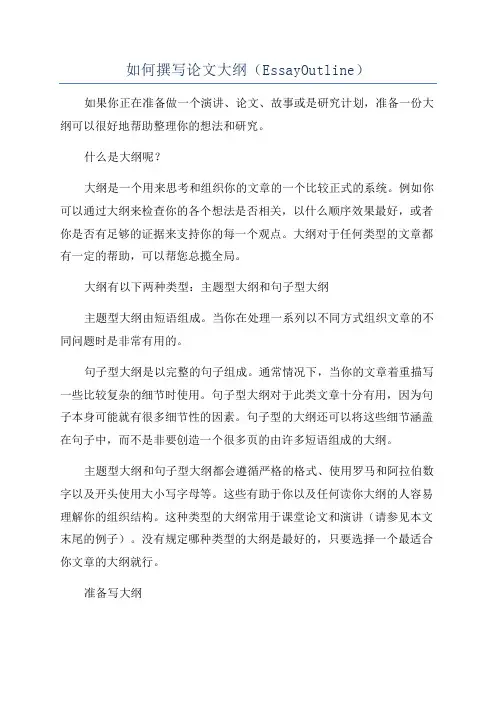
如何撰写论文大纲(EssayOutline)如果你正在准备做一个演讲、论文、故事或是研究计划,准备一份大纲可以很好地帮助整理你的想法和研究。
什么是大纲呢?大纲是一个用来思考和组织你的文章的一个比较正式的系统。
例如你可以通过大纲来检查你的各个想法是否相关,以什么顺序效果最好,或者你是否有足够的证据来支持你的每一个观点。
大纲对于任何类型的文章都有一定的帮助,可以帮您总揽全局。
大纲有以下两种类型:主题型大纲和句子型大纲主题型大纲由短语组成。
当你在处理一系列以不同方式组织文章的不同问题时是非常有用的。
句子型大纲是以完整的句子组成。
通常情况下,当你的文章着重描写一些比较复杂的细节时使用。
句子型大纲对于此类文章十分有用,因为句子本身可能就有很多细节性的因素。
句子型的大纲还可以将这些细节涵盖在句子中,而不是非要创造一个很多页的由许多短语组成的大纲。
主题型大纲和句子型大纲都会遵循严格的格式、使用罗马和阿拉伯数字以及开头使用大小写字母等。
这些有助于你以及任何读你大纲的人容易理解你的组织结构。
这种类型的大纲常用于课堂论文和演讲(请参见本文末尾的例子)。
没有规定哪种类型的大纲是最好的,只要选择一个最适合你文章的大纲就行。
准备写大纲1.确定主题。
你的论文主题是非常重要的。
试着用一句话或是短语来总结你论文的重点。
这将有助于保证你论文关注的重点。
2.识别主目录(主要章节论点)。
你的文章将涵盖哪些重点?介绍的部分通常会介绍你全部的要点,然后剩下的文章可以用来发展这些要点。
3.创建第一个章节(或者叫第一个论点)。
你的第一点想涵盖什么?如果文章是围绕着一个很复杂的术语,定义通常是一个很好地起点。
比如关于一个特定理论的文章,给出理论的大概背景知识也可能是一个很好的起点。
4.创建子论点。
在你确定所有章节重点内容(主要论点)之后,你需要创建一些观点来为你的重点内容提供支撑。
你使用的点取决于你将要涵盖的信息量,使用多少数量都是可以的。
按照惯例,每个章节至少包括两个条目。
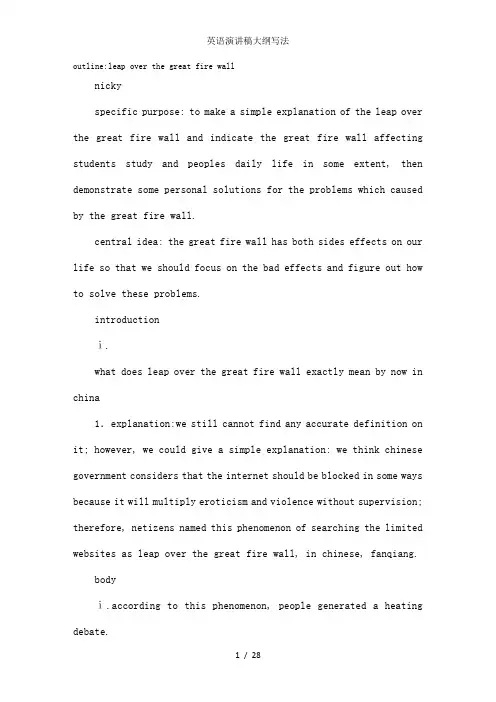
outline:leap over the great fire wall nickyspecific purpose: to make a simple explanation of the leap overthe great fire wall and indicate the great fire wall affectingstudents study and peoples daily life in some extent, thendemonstrate some personal solutions for the problems which causedby the great fire wall. central idea: the great fire wall has both sides effects on ourlife so that we should focus on the bad effects and figure out howto solve these problems. introduction ⅰ. what does leap over the great fire wall exactly mean by now inchina 1.explanation:we still cannot find any accurate definition onit; however, we could give a simple explanation: we think chinesegovernment considers that the internet should be blocked in some waysbecause it will multiply eroticism and violence without supervision;therefore, netizens named this phenomenon of searching the limitedwebsites as leap over the great fire wall, in chinese, fanqiang. body ⅰ.according to this phenomenon, people generated a heatingdebate.1. the pros:a).the great fire wall can help us stop spreading the negativeinformation b).provides a healthy and green network environment.2. the cons:a).it is on the pretext of spreading the negative informationbut for somepolitic profits: avoid spreading the information which isagainst the party. b).it is a good way for us to know how foreignfriends look at our china ⅱ.the great fire wall creates some bad impact on the universitystudents1.it is easy for students to lose their sense of right and wrong. 2.it obstructed students critical thinking and the objectiveworldview.4.it also obstructs the academic sources that students can beobtained, especially the external information.ⅲ.we have figured out some solutions based on the analysis anddiscussion.1.the government should publish a law that blocking the badinformation,while allowing the academic information for students; 2.we should appeal more and more netizens using their real nameson the internet for protecting the teenagers affected by the badinformation, while, it also can provide more privacy for the adultsto search the internet freely at the same time; 5.the designer of the great fire wall should be more confidentabout our netizen because we can distinguish most of the fake vediowhich is bad for our country. conclusion i. in a conclusion, we could have a deep understanding on thegreat fire wall from this problem-solving public speech. ii. moreover, we also found some bad influences of the great firewall.iii. nevertheless, we have figured out some personal solutionsfor it by intense discussions. iv. thus, we hope these bad influences can be improved anddeveloped well in the next long period.《英语演讲》教学大纲课程编号:课程类型:课程名称:英语演讲英文名称: public speaking in english 学分:适用专业:第一部分大纲说明一、课程的性质、目的和任务本课程向学生传授英语演讲的基本知识和演讲稿撰写技巧,通过对著名经典演讲词的学习鉴赏,了解英语演讲的目的、功能和修辞手段,通过对现代名人演讲词的赏析,了解当代演讲词的结构、风格和修辞特征;通过学习赏析和演讲实践,提高学生撰写演讲稿和进行即兴演讲的能力。
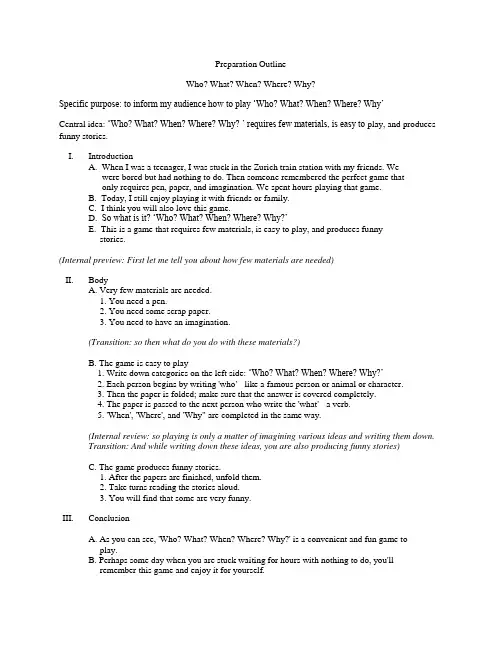
Preparation OutlineWho? What? When? Where? Why?Specific purpose: to inform my audience how to play ‘Who? What? When? Where? Why’Central idea: ‘Who? What? When? Where? Why?’ requires few materials, is easy to play, and produces funny stories.I.IntroductionA. When I was a teenager, I was stuck in the Zurich train station with my friends. Wewere bored but had nothing to do. Then someone remembered the perfect game thatonly requires pen, paper, and imagination. We spent hours playing that game.B. Today, I still enjoy playing it with friends or family.C. I think you will also love this game.D. So what is it? ‘Who? What? When? Where? Why?’E. This is a game that requires few materials, is easy to play, and produces funnystories.(Internal preview: First let me tell you about how few materials are needed)II.BodyA. Very few materials are needed.1. You need a pen.2. You need some scrap paper.3. You need to have an imagination.(Transition: so then what do you do with these materials?)B. The game is easy to play1. Write down categories on the left side: ‘Who? What? When? Where? Why?’2. Each person begins by writing 'who' - like a famous person or animal or character.3. Then the paper is folded; make sure that the answer is covered completely.4. The paper is passed to the next person who write the 'what' - a verb.5. 'When', 'Where', and 'Why" are completed in the same way.(Internal review: so playing is only a matter of imagining various ideas and writing them down.Transition: And while writing down these ideas, you are also producing funny stories)C. The game produces funny stories.1. After the papers are finished, unfold them.2. Take turns reading the stories aloud.3. You will find that some are very funny.III.ConclusionA. As you can see, 'Who? What? When? Where? Why?' is a convenient and fun game toplay.B. Perhaps some day when you are stuck waiting for hours with nothing to do, you'llremember this game and enjoy it for yourself.。
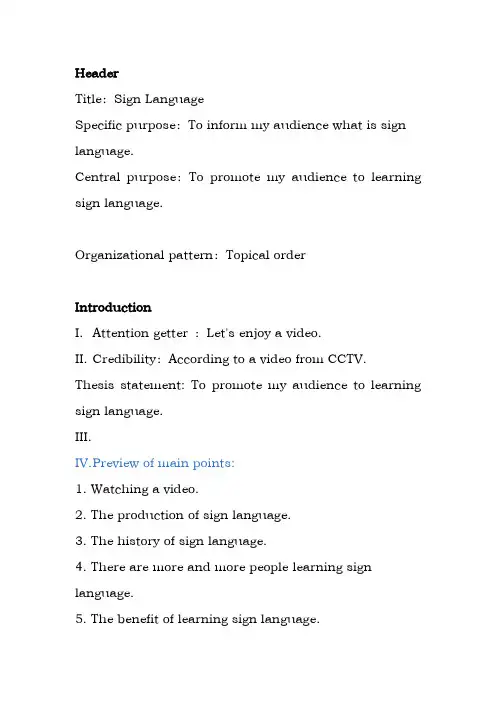
HeaderTitle:Sign LanguageSpecific purpose:To inform my audience what is sign language.Central purpose:To promote my audience to learning sign language.Organizational pattern:Topical orderIntroductionI.Attention getter :Let's enjoy a video.II.Credibility:According to a video from CCTV.Thesis statement: To promote my audience to learning sign language.III.IV.P review of main points:1. Watching a video.2. The production of sign language.3. The history of sign language.4. There are more and more people learning sign language.5. The benefit of learning sign language.6.ConclusionTransition: Now, let us begin today’s topic.BodyI.First main point :The production of sign languageA.Sign language is a language that does not speak!B.You do not hear yourself talk, you see yourself talk.C.It is developed for communities of deaf people. Transition :I believe that almost everybody who sitting here do not know the history of sign language.Second main point: The history of sign language.A.The history of sign language is littered with shockingevents.Transition: Nowadays, there are more and more people learning sign language. From children to seniors.Also ,most of people learn sign language as a kind of performance.III.T hird main point :Learning sign language has manybenefits.A.You can communicate through windows.B.Sign language is a 3D language.C.You can sign with your mouth gull.D.H earing parents can communicate with their deaf child.E.You can sign underwater.F.Sign language is a neat way to express yourself.G.Y ou can make friends with deaf people.H.S ign language brings together deaf and hearing people. Transition:Since sign language such useful, Now, let’s learn some simple sign language.IV.F ourth main point: Learning some simple sign languageA. HelloB. I love youC. SorryD. Thank youConclusionI.Restatement of thesis :Let’s learn sign languageII.Review of main points :①In my opinion, sign language is qualified for a real language.②It is universally used in deaf people and their relatives, friends and volunteers.③The unique grammar structure makes it effortless to reach the meaning.III.Final statement: Sign language is such a useful and interesting language; Let us learn sign language together.。
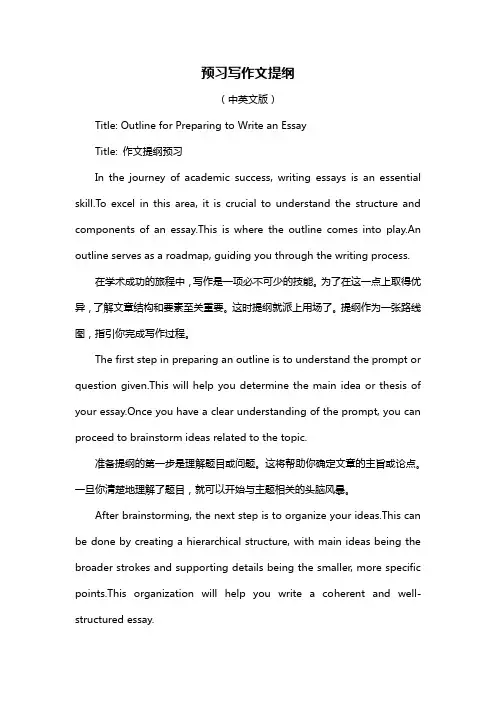
预习写作文提纲(中英文版)Title: Outline for Preparing to Write an EssayTitle: 作文提纲预习In the journey of academic success, writing essays is an essential skill.To excel in this area, it is crucial to understand the structure and components of an essay.This is where the outline comes into play.An outline serves as a roadmap, guiding you through the writing process.在学术成功的旅程中,写作是一项必不可少的技能。
为了在这一点上取得优异,了解文章结构和要素至关重要。
这时提纲就派上用场了。
提纲作为一张路线图,指引你完成写作过程。
The first step in preparing an outline is to understand the prompt or question given.This will help you determine the main idea or thesis of your essay.Once you have a clear understanding of the prompt, you can proceed to brainstorm ideas related to the topic.准备提纲的第一步是理解题目或问题。
这将帮助你确定文章的主旨或论点。
一旦你清楚地理解了题目,就可以开始与主题相关的头脑风暴。
After brainstorming, the next step is to organize your ideas.This can be done by creating a hierarchical structure, with main ideas being the broader strokes and supporting details being the smaller, more specific points.This organization will help you write a coherent and well-structured essay.头脑风暴之后,下一步是组织你的想法。
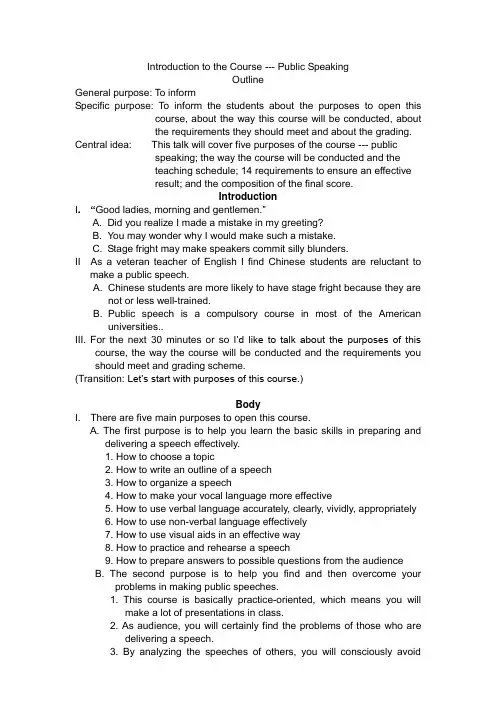
Introduction to the Course --- Public SpeakingOutlineGeneral purpose: To informSpecific purpose: To inform the students about the purposes to open this course, about the way this course will be conducted, aboutthe requirements they should meet and about the grading. Central idea: This talk will cover five purposes of the course --- publicspeaking; the way the course will be conducted and theteaching schedule; 14 requirements to ensure an effectiveresult; and the composition of the final score.IntroductionI. “Good ladies, morning and gentlemen.”A. Did you realize I made a mistake in my greeting?B. You may wonder why I would make such a mistake.C. Stage fright may make speakers commit silly blunders.II As a veteran teacher of English I find Chinese students are reluctant to make a public speech.A. Chinese students are more likely to have stage fright because they arenot or less well-trained.B. Public speech is a compulsory course in most of the Americanuniversities..III. For the next 30 minutes or so I’d like to talk about the purposes of this course, the way the course will be conducted and the requirements you should meet and grading scheme.(Transition: Let’s start with purposes of this course.)BodyI. There are five main purposes to open this course.A. The first purpose is to help you learn the basic skills in preparing anddelivering a speech effectively.1. How to choose a topic2. How to write an outline of a speech3. How to organize a speech4. How to make your vocal language more effective5. How to use verbal language accurately, clearly, vividly, appropriately6. How to use non-verbal language effectively7. How to use visual aids in an effective way8. How to practice and rehearse a speech9. How to prepare answers to possible questions from the audienceB. The second purpose is to help you find and then overcome yourproblems in making public speeches.1. This course is basically practice-oriented, which means you willmake a lot of presentations in class.2. As audience, you will certainly find the problems of those who aredelivering a speech.3. By analyzing the speeches of others, you will consciously avoidsimilar mistakes in your own performance.C. The third purpose is to help you overcome stage fright.1. Stage fright ranks very high among all the fears.2. Everyone has stage fear.3. There are at least five ways to overcome stage fright.---Acquire speaking experience.--- Make full preparation.---Think positively.---Use the power of visualization.---Don’t expect perfection.D. The fourth purpose is to prepare you for your future academic andprofessional life.1. Classroom presentation is currently what college students are mostlikely to face.2. Seminars, symposiums are occasions for your future academicstudies where you are very likely to be asked to make apresentation.3. Thesis oral defenses are what college students have to go through.4. Business/work reports are what one needs to write and present ifyou go professional.5. Political or even election speeches are not unlikely for some of youto make in the future.6. Ceremonial speeches are usually made impromptu.E. The fifth purpose is to help you build confidence and advance yourpersonal image.1. Through practicing and training, you may improve your way ofcommunicating your ideas orally to a group of people, which willnaturally help boost their confidence.2. The ability to beautifully deliver a speech in public will undoubtedlyupgrade your self-image and will make you more popular anywhereyou go.(Transition: Ok, those are the five main purposes to open this course. Some of you may wonder why I didn’t include “to help students practicetheir spoken English”. Well, spoken English is another course, as itis quite different from public speech. As a matter of fact, a relativelybetter command of oral English is required of those who want totake this course. Now let’s move on to how this course will beconducted.)II. This course will integrate theory into practice with focus on practice.A. The first four classes will be devoted to theory.1. The theory will be based on the lecture notes in our public mail box.2. The theory will be illustrated with examples, either verbal or visual.3. Volunteers will be assigned an extra speech, on which teachers willmake comments in order to further explain the theory.B. The remaining 12-13 classes will be used for classroom practice.1. Each student is required to give two speeches.a) The first speech to give should be informative.b) The second should be persuasive.2. There will be 4 to 5 students giving speeches each class.3. Both teachers and students are to comment on all the speechesmade.4. Each speech should last no more than 6 minutes, followed by 10minutes of Q&A and comments.(Transition: As you can see, more time will be spent on practice rather than theory. That is why we call it practice-oriented. To make our practice more effective, you are supposed to meet some requirements.)III. To make our class more effective and efficient, you are asked to fulfill the following requirements.A. Don’t skip classes and don’t be late.B. Be attentive in class.C. Prepare and compose the speech well and well in advance.D. Every speech should be written yourself.E. Practice and rehearse fully until you can make the speech withconfidence.F. Don’t bring your manuscript or preparation outline to the stage.G. Limit your speech to six minutes.H. Don’t use too many slides in your ppt. (10 slides will suffice for a6-minute talk.)I. Don’t play any video clip that lasts longer than 30 seconds.J. Hand in the preparation outline, manuscript, and speaking outline before each speech.K. Try to look at the audience and make eye contact as often as possible.L. Print out your evaluation charts and bring them to class.M. Discuss others’ speeches with group mates and grade them carefully and fairly.N. Don’t ask your teacher to revise your score.(Transition: There might be some other requirements along the way. I’ll let you know when they come up. Now let’s look at the last main point which yo u might be more concerned about --- grading.)IV. How to grade and evaluateA. The total score falls into the following parts:1. The first speech: 40% of the total score.2. The second speech: 45%3. Class performance: 15% including attendance and participation.4. Your grading will account for 30%, while the teacher’s 70%.B. Evaluation follows the following instructions.Evaluation ChartClass___________ Group ___________ Date ________________Name of speaker____________ Name of evaluator ____________Evaluating instructions:1. Vocal effect includes pronunciation, vocal variety, fluency, clarity, volume,pacing (rhythm).2. Verbal language includes grammar, accuracy, maturity, appropriateness,and vividness.3. Structure refers to introduction, body and ending.4. Body language contains eye contact, gesture, facial expression, andposture.5. Visual aid mainly includes ppt. or video clips with 10 slides for ppt. and 30seconds for video clips.6. Overall Effect refers to the general impression, whether the speech isinformative or persuasive, and the speaker’s performance in Q&A session.7. Item 7 will be graded by the teacher after the outline is e-mailed to theteacher’s mail box.(Transition: With the grading done, the introduction to this course is about to wind up. But before that, let’s go over the whole thing briefly so that you won’t forget immediately and then can make an informed decision as to whether you will choose this cou rse, since it’s still in the shopping week.)ConclusionI. Today’s opening speech consists of 4 parts.A. There are 5 purposes to open this course.B. This course combines theory with practice and will mainly focus onpractice.C. To ensure the effectiveness of the course, you are asked to follow 14requirements.D. Lastly we talked about grading. Don’t forge t, your grading also counts. II. The ultimate goal of this course is to enable you to make satisfactory public speeches with sufficient preparation and practice.II. I keep my fingers crossed that one day you will be eloquent speakers in whatever fields you are.III. Thank you for your patience.。
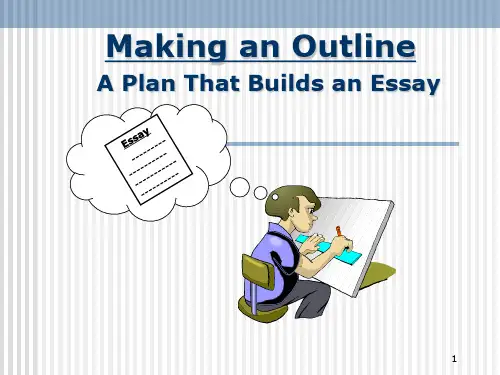
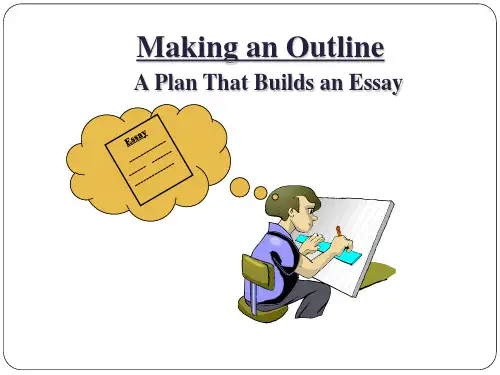
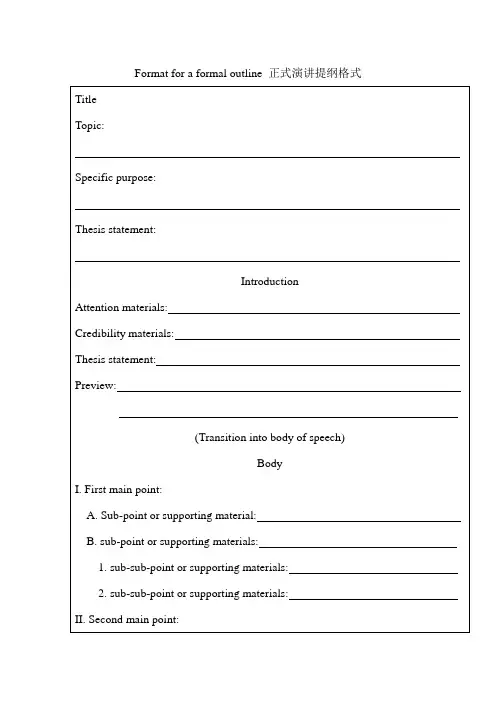
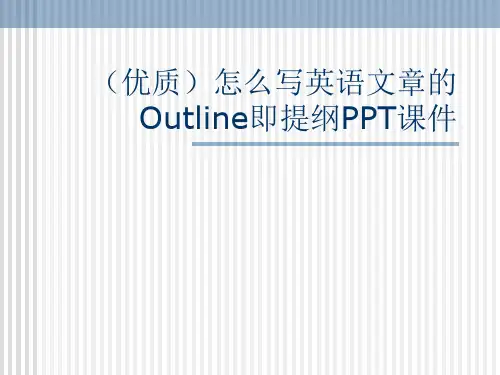
英语topic outline提纲范文I. Introduction- Definition of topic- Importance of topicII. Background Information- History of topic- Current situation- Relevant statisticsIII. Causes of the Issue- Economic factors- Social factors- Political factorsIV. Effects of the Issue- Impact on individuals- Impact on communities- Impact on society as a wholeV. Solutions to the Issue- Government policies- Community initiatives- Individual actionsVI. Case Studies- Examples of successful solutions - Examples of ongoing challenges VII. Conclusion- Recap of main points- Call to actionI. Introduction- 主题定义- 主题重要性II. 背景信息- 主题的历史- 目前的状况- 相关统计数据III. 问题的原因- 经济因素- 社会因素- 政治因素IV. 问题的影响- 对个人的影响- 对社区的影响- 对整个社会的影响V. 解决方案- 政府政策- 社区倡议- 个人行动VI. 案例研究- 成功解决方案的例子- 持续挑战的例子VII. 结论- 主要观点回顾- 行动号召。
英语作文筹备计划范文模板英文回答:Writing Preparation Plan Template。
Step 1: Pre-writing。
Brainstorming: Generate ideas through freewriting, mind mapping, or brainstorming sessions.Research: Gather relevant information from credible sources such as books, articles, and online resources.Outline: Create a logical structure for your essay, including an introduction, body paragraphs, and conclusion.Step 2: Drafting。
Write an engaging introduction: Hook your reader and clearly state your thesis statement.Develop body paragraphs: Support your thesis statement with evidence from your research and analysis.Provide smooth transitions: Use transitional words and phrases to connect your ideas and paragraphs.Write an insightful conclusion: Summarize your main points and offer a final thought or call to action.Step 3: Revising。
Self-evaluate: Read your essay critically and assess its content, structure, and language.Seek feedback: Ask a trusted friend, teacher, or tutor to provide feedback on your writing.Revise for content: Ensure your essay is well-organized, supported by evidence, and free from logical fallacies.Revise for style: Improve the clarity, conciseness,and flow of your writing.Revise for grammar and mechanics: Pay attention to grammar, punctuation, and spelling.Step 4: Editing。
考试时英语作文怎么列提纲Creating an outline for an English essay during an exam can be a crucial step to ensure a well-structured and coherent piece of writing. Here's a straightforward approach to help you draft an effective outline quickly:1. Understand the Prompt: Before you start, make sure you understand what the essay question is asking for. Highlight or note the key elements of the prompt.2. Choose a Structure: Decide whether your essay will followa narrative, argumentative, or expository structure. Thiswill guide how you organize your points.3. Introduction: Your outline should start with a brief overview of what you will discuss. Include the main idea (thesis statement) and possibly a brief mention of the points you will cover.4. Body Paragraphs: Break down your essay into several main points that support your thesis. Each point should be a separate paragraph in your outline. For example:- Point 1: Topic Sentence, Explanation, Example, Analysis - Point 2: Topic Sentence, Explanation, Example, Analysis - Point 3: Topic Sentence, Explanation, Example, Analysis5. Counterarguments: If applicable, include a section where you address potential counterarguments to your points.6. Conclusion: Summarize your main points and restate your thesis in a new way. Include a final thought or call to action if appropriate.7. Time Management: Allocate time for each section of your essay based on the outline. This will help you pace yourself during the exam.8. Transitions: Note how you will transition between points to maintain the flow of your essay.9. Word Choice: Make a note of any specific vocabulary or phrases you want to use to enhance your essay.10. Review: Quickly go over your outline to ensure it logically flows and that all points are clear and relevant to the prompt.Remember, the outline is a flexible tool. You may need to adjust it as you write your essay, especially if you come up with new ideas or if you find that some points are not as strong as you initially thought. The key is to keep it simple and focused on the task at hand.。
和准备有关的作文提纲英文回答:Preparing for something is an essential step in achieving success. Whether it is preparing for a test, a job interview, or a presentation, proper preparation can make a significant difference in the outcome. It allows us to gain knowledge, build confidence, and anticipate potential challenges. In my opinion, there are several reasons why preparation is crucial.Firstly, preparation helps us acquire knowledge and understanding about the subject matter. For instance, when preparing for a test, we study the relevant materials, review notes, and practice solving problems. This process enables us to grasp the concepts and information, which ultimately leads to better performance. Similarly, when preparing for a job interview, we research the company, learn about its values and goals, and familiarize ourselves with the job requirements. This knowledge allows us toanswer questions effectively and demonstrate oursuitability for the position.Secondly, preparation allows us to build confidence. When we are well-prepared, we feel more self-assured and capable. This confidence translates into better performance and the ability to handle unexpected situations. For example, when giving a presentation, thorough preparation gives us the confidence to speak clearly, engage the audience, and respond to questions confidently. On theother hand, lack of preparation can lead to anxiety and nervousness, which may hinder our ability to convey our ideas effectively.Furthermore, preparation helps us anticipate and overcome potential challenges. By identifying potential obstacles in advance, we can develop strategies to address them. For instance, when preparing for a sports competition, athletes analyze their opponents' strengths and weaknesses and devise tactics accordingly. This preparation enables them to adapt to different scenarios and increase their chances of success. Similarly, in the business world,entrepreneurs prepare contingency plans to mitigate risks and overcome unexpected challenges. This preparation allows them to navigate through uncertainties and maintain their competitive edge.In conclusion, preparation plays a vital role in achieving success. It provides us with the necessary knowledge, builds our confidence, and helps us overcome challenges. Whether it is for academic, professional, or personal endeavors, proper preparation sets the foundation for excellence. Therefore, it is crucial to invest time and effort in preparing for any task or goal.中文回答:准备对于取得成功是至关重要的一步。
课题初步提纲写法作文Topic Preliminary Outline.英文回答:When creating a preliminary outline for a topic, it is important to consider the main points that will be covered in the essay or presentation. The outline serves as a roadmap for the writer, helping to organize thoughts and ensure that all relevant information is included.The first step in creating a preliminary outline is to brainstorm and jot down all the ideas that come to mind regarding the topic. This can be done in the form of a mind map, a list, or any other method that works for the individual. Once all the ideas are recorded, the next step is to group related ideas together and identify the main themes or arguments that will be addressed.After identifying the main themes, it is important toprioritize them and decide on the order in which they will be presented. This will help to create a logical flow in the essay or presentation, making it easier for the audience to follow the discussion.Next, for each main theme, sub-points and supporting evidence should be identified. This will help to ensurethat the content is well-developed and comprehensive. It is also important to consider any opposing viewpoints and how they will be addressed within the discussion.Finally, the preliminary outline should be reviewed and revised as needed. It is a flexible tool that can be adjusted as the writing process progresses and new ideas emerge.中文回答:在为课题创建初步提纲时,重要的是要考虑将在文章或演示中涉及的主要观点。
如何完成目标作文提纲英文回答:In order to achieve a goal, it is important to have a plan and to write a detailed outline. An outline will help you to break down your goal into smaller, more manageable steps, and it will also help you to stay on track as you work towards your goal.When writing an outline, it is important to consider the following elements:Goals: The first step is to identify your goal. What do you want to achieve? What is the final outcome that you are working towards?Objectives: Once you have identified your goal, you need to develop a list of objectives that will help you to achieve your goal. These objectives should be specific, measurable, achievable, relevant, and time-bound.Action steps: For each objective, you need to develop a list of action steps that will help you to achieve your objective. These action steps should be specific, measurable, and time-bound.Timeline: You also need to develop a timeline for your outline. This timeline will help you to track your progress and to ensure that you are on track to achieve your goal.Once you have completed your outline, you can begin working towards your goal. By following the steps in your outline, you will be more likely to achieve your goal on time and on budget.中文回答:如何完成目标作文提纲。
Introduction to the Course --- Public SpeakingOutlineSpecific purpose: To inform the students about the aspects of the course --- Public SpeakingCentral idea: The four aspects of this course include five purposes of opening the course, the way the course will beconducted and the teaching schedule, 14 requirements toensure an effective result; and the evaluation andgrading.IntroductionI. First let me ask you three questions:A. A. Why do you choose this courseB.What is a good speechC.What is the greatest obstacle if one wants to deliver a great speech II. As a veteran teacher of English I find Chinese students are reluctant to make a public speech.A.Chinese students are more likely to have stage fright because theyare not or less trained.B.Public speech is a compulsory course in most of the Americanuniversities.III. For the next 30 minutes or so I’d like to talk about 4 things: the purposes of this course, the way the course will be conducted, the requirements you should meet and grading scheme.(Transition: Let’s start with the purposes of this course.)BodyI. There are five main purposes to open this course.A. The first purpose is to help you learn the basic skills in preparingand delivering a speech effectively.1. The first is how to choose a topic2. The second is to write an outline of a speech.3. The third is to organize a speech4. The fourth is to make your vocal language more effective5. The fifth is to use verbal language effectively6. The sixth is to use non-verbal language effectively,7. The seventh is to use visual aids in an effective way.8. The eighth is to practice and rehearse a speech.9. The ninth is to prepare answers to possible questions from theaudience.B. The second purpose is to help you find and then overcome yourproblems in making public speeches.1. This course is basically practice-oriented, which means youwill make a lot of presentations in class.2. As audience, you will certainly find the problems of those whoare delivering a speech.3. By analyzing the speeches of others, you will consciously avoidsimilar mistakes in your own performance.C.The third purpose is to help you overcome stage fright.1. Stage fright ranks very high among all the fears.2. Everyone has stage fear.3. There are at least five ways to overcome stage fright.a. Acquire speaking experience.b. Make full preparation.c. Think positively.d. Use the power of visualization.e. Don’t expect perfection.D.The fourth purpose is to prepare you for your future academic andprofessional life.1. Classroom presentation is currently what college students aremost likely to face.2. Seminars or symposiums are occasions for your future academicstudies where you are very likely to be asked to make apresentation.3. Thesis oral defenses are what college students have to gothrough.4. Business/work reports are what one needs to write and presentif you go professional.5. Political or even election speeches are not unlikely for someof you to make in the future.6. Ceremonial speeches are usually made impromptu.E. The fifth purpose is to help you build confidence and advance yourpersonal image.1. Through practicing and training, you may improve your way ofcommunicating your ideas orally to a group of people, which willnaturally help boost their confidence.2. The ability to beautifully deliver a speech in public willundoubtedly upgrade your self-image and will make you morepopular anywhere you go.(Transition: Ok, those are the five main purposes to open this course.Some of you m ay wonder why I didn’t include “to help studentspractice their spoken English”. Well, spoken English isanother course, as it is quite different from public speech.As a matter of fact, a relatively better command of oral Englishis required of those who want to take this course. Now let’smove on to how this course will be conducted.)II. This course will integrate theory into practice with focus on practice.A.The first four classes will be devoted to theory.1.The theory will be based on the lecture notes in our class emailbox.2.The theory will be illustrated with examples, either verbal orvisual.B.Volunteers will be assigned extra speeches, which will take 2 moreclasses.C.The remaining 10 classes will be used for classroom practice.1.Each student is required to give two speeches.a. The first speech to give should be informative.b. The second should be persuasive.2. There will be 4 students giving speeches each class.3. Both teachers and students are to comment on all the speechesmade.4. Each speech should last no more than 10 minutes, followed by10 minutes of Q&A and comments and 2 minutes for grading. (Transition: As you can see, more time will be spent on practice rather than theory. That is why we call it practice-oriented. To make our practice more effective, you are supposed to meet some requirements.)III. To make our class more effective and efficient, you are asked to fulfill the following 14 requirements.1.Don’t skip classes and don’t be late.2.Be attentive in class.3.Prepare and compose the speech well and well in advance.4.Every speech should be written yourself.5.Practice and rehearse fully until you can make the speech withconfidence.6.Don’t bring your speech draft or preparation outline to the stage.7.Limit your speech to 10 minutes.8.Don’t use too many slides in your ppt. (12 slides will sufficefor a 10-minute talk.)9.Don’t play any video clip t hat lasts longer than 1 minute.10.Hand in the preparation outline, speech draft, and speaking outlinebefore each speech.11.Eye contact contributes a lot to the scoring.12.Print the evaluation charts and bring them to class from the fifthweek.13.Discuss others’ speeches with group mates and grade them carefullyand fairly.14.Don’t ask me to revise your score.(Transition: There might be some other requirements along the way. I’ll let you know when they come up. Now let’s look at the last main point which you might be more concerned about --- grading.)IV. How a speech is graded and evaluatedA. The total score falls into the following parts:1. The first speech accounts for 40%.2. The second speech accounts for 45%.3. Class performance accounts for 15% including attendance andparticipation.Note: Students’grading will account for 30%, while the teacher’s 70%.B. Each speech is evaluated according to the following instructions.Evaluation ChartClass___________ Group ___________ Date ________________Name of speaker____________ Name of evaluator ____________Evaluating instructions:1.Vocal effect includes pronunciation, vocal variety (cadence), fluency,clarity, volume.2.Verbal language includes grammar, accuracy, appropriateness, andvividness and rhetorical devices.3.Structure refers to opening, body and ending.4.Body language contains eye contact, gesture, facial expression, andposture.5.Visual aid mainly includes ppt. or video clips with no more than 12slides for ppt. and 1 minute for video clips.6.Overall Effect refers to the general impression, whether the speechis informative or persuasive, and the speaker’s performance in Q&A session.7.Outlines will be graded by the teacher only.(Transition: With the grading done, the introduction to this course is about to wind up. But before th at, let’s go over the whole thing briefly so that you won’t forget immediately and then can make an informed decision as to whether you will buy this co urse, since it’s still the shopping week.)ConclusionI. Today’s opening speech consists of 4 parts.A. There are 5 purposes to open this course.B. This course combines theory with practice and mainly focuses onpractice.C. To ensure the effectiveness of the course, you are asked to follow14 requirements.D. The final score is graded by both the teacher and the students. II. The ultimate goal of this course is to enable you to make satisfactory public speeches with sufficient preparation and practice.III.I keep my fingers crossed that one day you will be eloquent speakers in whatever fields you are.IV.Thank you.。